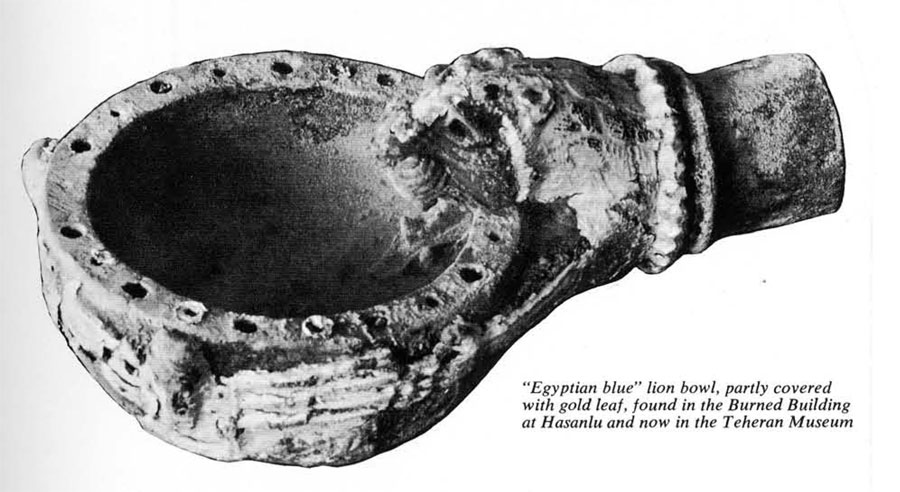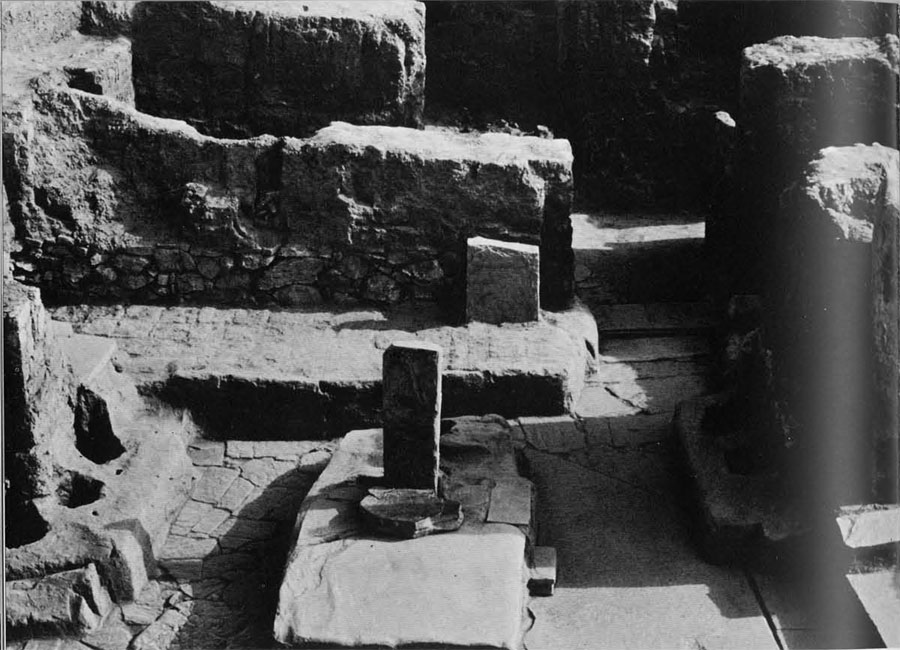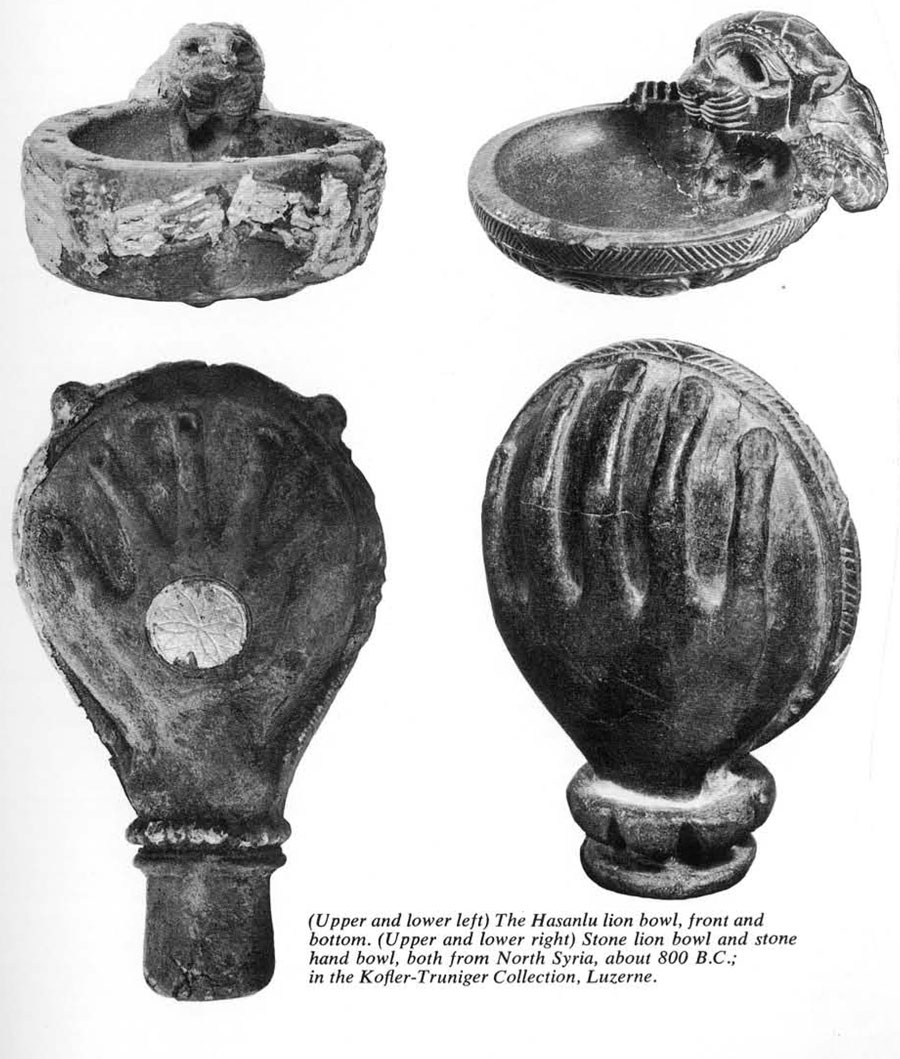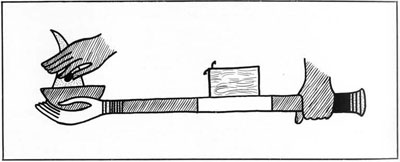 From June to September, 1960, Robert H. Dyson, Jr. led the fifth campaign of excavations at Hasanlu, south of Lake Urmia in northwestern Iran. The campaign was a joint effort of the Iranian Archaeological Service, the Metropolitan Museum of Art in New York, and the University Museum in Philadelphia.
From June to September, 1960, Robert H. Dyson, Jr. led the fifth campaign of excavations at Hasanlu, south of Lake Urmia in northwestern Iran. The campaign was a joint effort of the Iranian Archaeological Service, the Metropolitan Museum of Art in New York, and the University Museum in Philadelphia.
The campaign’s most valuable find was made by the expedition leader himself while clearing a newly found interior wall of a substantial building on the citadel mound, provisionally labeled Burned Building II and dating to between 1000 and 800 B.C. Part of the thick mud-brick wall had subsided in the fire which destroyed the building, leaving a niche-like cavity into which rubble from the collapsed superstructure had firmly lodged itself. From this lump of debris emerged, miraculously undamaged, the beautiful object here discussed.
Judging by its location, the piece had been kept on the second floor of the building, where the more valuable part of the objects found was apparently stored; among other finds made at the level of the collapsed upper floor were an alabaster vase, a number of stone molds for casting bronze axes, and many carved ivory fragments, probably decorative elements from pieces of furniture. The fine material and careful manufacture of these objects suggest that they were set aside for someone eminently privileged, like a ruler of Hasanlu or quite possibly even some local deity. One reason for tentatively ascribing a religious rather than a secular use to this structure is the conspicuous presence at the entrance of Burned Building II of a slab of bluish gray basalt, worn smooth by wear and perhaps by being repeatedly anointed–as sacred stones often were.

The bowl is made of blue frit or crystalline calcium-copper tetrasilicate, a material closely related to glass in its composition, but not fired to the point of vitrification and commonly–though deceptively–known as “faience,” “Egyptian blue,” or “lapis lazuli paste.” Its fabrication was known in Egypt from a very early period, but in western Asia it only came into use in the second half of the second millennium B.C. as a substitute for the more costly lapis lazuli. It was cast in a mold which may in turn have been taken from a model in wax.
The vessel has a total length of 15.2 cm., and consists of a flattened hemispherical bowl, 8.9 cm. in diameter, and a tubular extension (now slightly splayed, but cracks at the end indicate that this is probably not its original state.) The surface of the tube is irregular and was evidently inserted into some other material and hence not meant to be seen. As the tube widens toward the bowl it is encircled by a convex molding and a beaded molding, from which the foreparts of a lion emerge. The paws grasp the sides of the bowl, while the open mouth masks the hole where the tube opens into the bowl.
 The lion’s mane is indicated by lozenges hatched in alternating directions. The heart-shaped ears are close to the neck, and the face is set off from the mane by a hatched, projecting ruff. Under the hollow eyes, which were probably inlaid with some other material, the cheeks are creased by wrinkles which converge upon the nose. The whiskers are indicated by a further set of curved wrinkles. In the gaping jaws the canines are especially emphasized. The undulating tongue merges into the bottom of the bowl.
The lion’s mane is indicated by lozenges hatched in alternating directions. The heart-shaped ears are close to the neck, and the face is set off from the mane by a hatched, projecting ruff. Under the hollow eyes, which were probably inlaid with some other material, the cheeks are creased by wrinkles which converge upon the nose. The whiskers are indicated by a further set of curved wrinkles. In the gaping jaws the canines are especially emphasized. The undulating tongue merges into the bottom of the bowl.
Where the flattened claws of the lion end, the decoration of the sides continues in the manner of a frieze by two male winged sphinxes with beards and horned miters. Their couchant bodies are in profile, their heads facing and flanked by their horizontally spread wings, each made up of three layers of parallel feathers. The flat rim of the bowl has a series of round holes, of which every second one contains a tiny socket of gold lead, as if they had been alternately inlaid with semiprecious stones and gold-covered knobs. More gold foil covers the lion protome, the circlet of beads, and the sphinxes.
The bottom of the bowl reveals yet another scheme of decoration: a human hand with delicate fingers–possibly intended as a woman’s hand–is rendered in low relief, as if supporting the bowl. To its center adheres a disc of gold foil engraved with a compass-drawn double rosette. A tiny speck of gold foil is all that remains of the golden fingernails.


Although unique because of its size, the peculiar combination of elements, and the precious materials that went into its fabrication, our bowl is by no means the only one of its type known. There is a whole class of similar objects in various materials–mostly steatite–from a number of sites throughout western Asia, centering around North Syria, decorated either with lions or with human hands. Stefan Przeworski, in Syria, XI (1930), has drawn together a number of these objects and has argued for their use as censers. The main evidence in favor of his thesis is that the censers shown in use on Egyptian reliefs of the Middle Kingdom actually do consist of a bowl supported by the effigy of a human hand and mounted on a long handle, held in horizontal position by its far end. The motif of a human hand supporting a bowl may well have been passed on from Egypt to Syria.
The famous German Assyriologist Walter Andrae, after a detailed study of the objects of this class found at Sam’al (now Zencirli) in Turkey near the Syrian border, arrived at a different conclusion: he found that the objects themselves showed no traces of burning and that the tubular channels leading into the side of the bowl could not have fed air to incense burning in the bottom of the bowl. Obviously the tubes served in pouring liquid from a larger container into the bowl, form which the required amount could then easily be taken. Andrae therefore called them “stone spoons,” but as he found that the tubular extension had in most cases been roughened with a file, he believed that this part of the object had been fitted into a long wooden tube.
A more satisfactory explanation is offered by R.D. Barnett of the British Museum in discussing ivory hand bowls and lion bowls from the Assyrian capital at Kalhu (Nimrud). These objects, in a different medium and on a different scale, reproduce the shape and the decoration of the bowl from Hasanlu. Barnett points to the fact that in a Late Bronze Age (14th – 13th century B.C.) shrine at Lachish in Palestine a hand-shaped ivory spoon with tubular extension was actually found stuck into a flask made from hollow elephant tusk. These hand-shaped objects therefore served at the same time as stoppers and to pour out the contents of the flask in small quantities at a time. The Lachish flask is decorated with a woman’s head, indicating its use as a toilet article. Hands are often, and female heads are sometimes, seen represented on tusks and horns brought by the Syrians to Egypt with oil or ointment as tribute–as shown by tomb paintings of the New Kingdom. Examples of such tusks and horns have actually been found in Egypt.
 The combination of tubular flask and hand-shaped spoon-stopper was imitated in clay, usually with a polished brown slip, in a number of examples found both at the centers of Hittite culture in Asia Minor and in adjacent regions, including North Syria. All apparently date to the 15th and 13th centuries B.C. The Anatolian specialist, Kurt Bittel has suggested that such clay arms may have been used to pour libations for divine statues which were either physically inaccessible or religiously taboo for human hands–or both. The use of the clay arm would have extended the reach of the human arm while at the same time preserving the isolation of the sacred image against contact with profane hands. This hypothesis, so completely in keeping with ancient Near Eastern ideology, is certainly most attractive and could equally well apply to the Hasanlu lion bowl, if it had been fitted as a mouthpiece to a container of liquid destined for a cult statue or a cult symbol. Under such circumstances it would be understandable that no pains would have been spared to make it as beautiful as possible, The liquid may have been either wine or beer, as is assumed for the Hittite libation vessels, or perfumed oil for anointing, as has been plausible suggested for the Egyptian and Palestinian tusks and horns. Both assumptions are supported by textual evidence.
The combination of tubular flask and hand-shaped spoon-stopper was imitated in clay, usually with a polished brown slip, in a number of examples found both at the centers of Hittite culture in Asia Minor and in adjacent regions, including North Syria. All apparently date to the 15th and 13th centuries B.C. The Anatolian specialist, Kurt Bittel has suggested that such clay arms may have been used to pour libations for divine statues which were either physically inaccessible or religiously taboo for human hands–or both. The use of the clay arm would have extended the reach of the human arm while at the same time preserving the isolation of the sacred image against contact with profane hands. This hypothesis, so completely in keeping with ancient Near Eastern ideology, is certainly most attractive and could equally well apply to the Hasanlu lion bowl, if it had been fitted as a mouthpiece to a container of liquid destined for a cult statue or a cult symbol. Under such circumstances it would be understandable that no pains would have been spared to make it as beautiful as possible, The liquid may have been either wine or beer, as is assumed for the Hittite libation vessels, or perfumed oil for anointing, as has been plausible suggested for the Egyptian and Palestinian tusks and horns. Both assumptions are supported by textual evidence.
As a number of other “Egyptian blue” objects of Assyrianizing style were found at Hasanlu, the lion bowl may also have been made locally, or at least not farther away than in neighboring Assyria. The lion, and especially the sphinxes’ heads, with their horned mitres and beards, are definitely Assyrian in character. But in its combination of bowl and tube, and its decoration with lion protome, hand, and sphinxes, the object betrays its ultimate derivation from the North Syrian prototype. It is, therefore, not likely to be older than about 850 B.C., when Assyria entered into close contact with Syria through the victorious campaigns of Shalmaneser III. It ought to be older than about 800 B.C., when the citadel of Hasanlu probably was destroyed, as suggested by both internal evidence (Carbon-14 dates) and external indications (Menua, king of Urartu from 810 to 781 B.C., recorded his conquest of this region on a rock not far away). The excavated counterparts to our lion bowl in stone and ivory come, without exception, from ninth to seventh century B.C. contexts. Syrian workmanship is likely for all of them.
If both the structure of the Hasanlu lion bowl and the motifs used in its decoration go back to a North Syrian prototype, the style of its execution betrays an influence closer at hand: that of the Assyrian court, best known to us through the palace reliefs. Representations of the king of beasts, especially, are so widespread that we can distinguis the stylistic development almost from one region to another. In the reign of Assurnasirpal II (883-859 B.C.) and Shalmaneser III (858-824 B.C.), a stylization prevailed which emphasized the terrifying force and majestic bearing of the lion at the expense of realistic portrayal. Gaping jaws, huge fangs, wrinkled noses, and furrowed brows are the means by which the end–that of inspiring awe–is achieved. With the reign of Tiglathpilesar III (745-727 B.C.), a trend toward naturalism sets in, which culminates in the painstakingly lifelike lion hunt scenes of Assurbanipal (668-631 B.C.).
The lion mask on the Hasanlu receptacle obviously belongs to the former school, which seems to have left a deep impression amongst Assyria’s neighbors. We know that in neighboring Urartu (modern Armenia), the trend in the seventh century was toward stylization of the older Assyrian model: several lion heads in the round, showing a strong family resemblance to our lion bowl, have their snarling features dissolved into semicircles and angular zigzags. In contrast to this, the centers of Near Eastern civilization were experimenting with naturalism. At the Achaemenian court in sixth and fifth century Persia, however, a style again aiming principally at pride and strength, and making intensive use of geometric forms, is evolved. This “heraldic” style may well be a legacy of the earlier Iranian style so masterfully exemplified by the lion bowl from Hasanlu.
